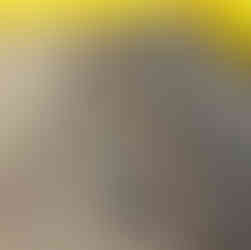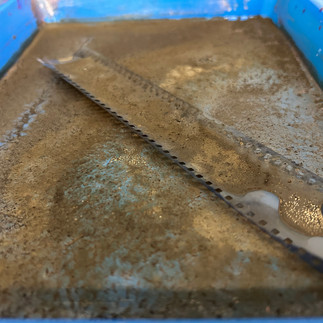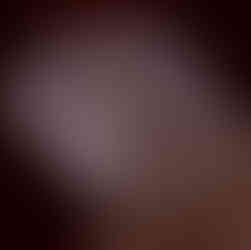24/09/25 - Soil Visibility
- Ritchard Allaway

- Sep 24
- 4 min read
24th September 2025
Experimentation: Visibility and Readability

This entry is another of my delayed summer blogs, finally surfacing after a period of heavy workload. It reflects on a walk I made along part of the Cleveland Way in April and the visual outcomes that emerged from working with soil gathered on route. I will recap the location, describe how I prepared the soil solution, and consider the outcomes produced when it was applied directly to photographic negatives. These results function as visual translations of site, place, and the living landscape underfoot, present recordings of soil as a non-human agent. Read through an autoethnographic unearthing methodology, they evidence a moment of encounter: my way of knowing soil in situ, making meaning through the act of revealing. This leads me to reflect on cultural ideas of visibility, what value arises when the invisible is made visible through artistic process, and how does that visibility become bound to a possible power, ownership of interpretation and meaning?
My location was the Cleveland Way. The location (as discussed in my blog entry Walking, Reading, Unearthing), was chosen due to its historical significance within the Moors. Spanning 109 miles from Helmsley, North Yorkshire to Filey Brigg, the route encompasses notable landmarks such as Whitby Abbey, Scarborough Castle, Mount Grace Priory, and the White Horse of Kilburn. Traversing small villages, farmland, heather moorland, and peatland, the Cleveland Way offers a rich variety of terrains. It remains a popular route for walkers; many of whom including friends and family have explored parts of it over the years. My interest lay in investigating how a popular, visually rewarding walking route could also reveal the hidden networks and energies underfoot, and whether these contribute to the aesthetic pleasures of the walking experience.

Throughout the walk I engaged closely with the landscape, its surfaces, textures, views, and sensory encounters. Alongside field notes that recorded my experience of walking through this rural terrain, I gathered images and unearthed soil samples from four distinct positions. At each point, I first took electrical readings to register the micro-activity underfoot. These readings acted as quantifiable data, suggesting how nutrients and vitality might differ across the landscape and how each soil sample carried traces of its specific location.
The making process followed the method I have used throughout this research: transforming soil into a solution for application and translation. Each sample was dried, ground with a pestle and mortar, and filtered into a sodium water solution. The mixture was agitated for several hours and then left to ‘brew’. Unlike my usual approach, applying the solution onto silver nitrate-soaked filter paper for chromatography, here I experimented with 35mm light-sensitive negative film. My intention was to see how the soil solution would react with a pre-made, traditional photographic material. In a way, there was an element of play in this decision: removing the camera as mediator and instead placing the unearthed landscape directly onto a medium designed to record and develop images.
The soil solutions were poured into four trays, each labelled according to its corresponding position and electrical output:
· Position 1 – 0.579V
· Position 2 – 0.740V
· Position 3 – 1.042V
· Position 4 – 0.941V
Strips of developed negatives were cut and placed into each tray, where they remained for several days. I was uncertain how long they should stay immersed but based on earlier experiments I knew soil interactions with photographic material require time. I therefore set a minimum period of 36 hours, extending it until the soil solutions had fully evaporated and dried. In total, the negatives were left for around eight days, allowing the soil to leave its imprint through slow, material exchange.
The reactive material exchange presents itself as both engaging and full of potential, inviting further exploration through traditional darkroom methods, such as using an enlarger to expose the negatives onto photographic paper, as well as through digital processes, including my original intention of scanning the negatives with a specialised film scanner.
The digitised outcomes presented here capture micro-active energy recorded on a 35mm negative, later scanned at 1600% magnification. This process reveals the soil’s reaction to the photographic material itself, producing images that make visible the activity underfoot. The resulting frames almost resemble nebulae, and what might be seen above in space could easily be mistaken for these highly active, living soil networks. Within a single 35mm frame, clusters of micro-activity become tangible, revealing a remarkable density of life contained within a tiny parameter.
These images visualise speculative energies, both scientific and artistic evidence of living networks connecting soil, sensation, and landscape. They make apparent exoelectrogenic movement, microbial activity, and the hidden exchanges that shape landscapes above. The soil negatives reveal an active space of interaction, a living network of energy transfer, collaboration, and cellular exchange operating beyond immediate perception.
Within my autoethnographic methodology, these visual outcomes translate the invisible into a physical product of communication. By revealing what normally goes unnoticed, the soil negatives make micro-organism activity and energetic exchanges legible, establishing their existence within my research. This visibility enables the invisible to take on new roles: as material evidence and as a participant within artistic cultural discourse. The Cleveland Way, in this context, becomes a site where these hidden systems are acknowledged and given form, situating human experience alongside microbial networks and extending the boundaries of what can be perceived, valued, and represented.







































Comments